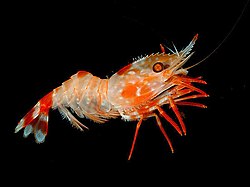| Heterocarpus ensifer | |
|---|---|
 | |
| Scientific classification | |
| Kingdom: | Animalia |
| Phylum: | Arthropoda |
| Class: | Malacostraca |
| Order: | Decapoda |
| Suborder: | Pleocyemata |
| Infraorder: | Caridea |
| Family: | Pandalidae |
| Genus: | Heterocarpus |
| Species: | H. ensifer |
| Binomial name | |
| Heterocarpus ensifer | |
Heterocarpus ensifer is a species of deep-water shrimp. The nominate subspecies is found in the Atlantic Ocean from Spain and Madeira to Angola and from North Carolina to the Gulf of Mexico and Caribbean Sea; other subspecies occur in the Pacific Ocean and around the Philippines and Indonesia. [2] Despite being one of the most abundant shrimp in some areas, [3] its biology is still poorly known. [4] These deep water crustaceans are most copious between 300 and 400m. Their distribution demonstrates an ability to adapt well to distinct environments. [5] It is generally found at depths of 200–885 m (656–2,904 ft). [2]
